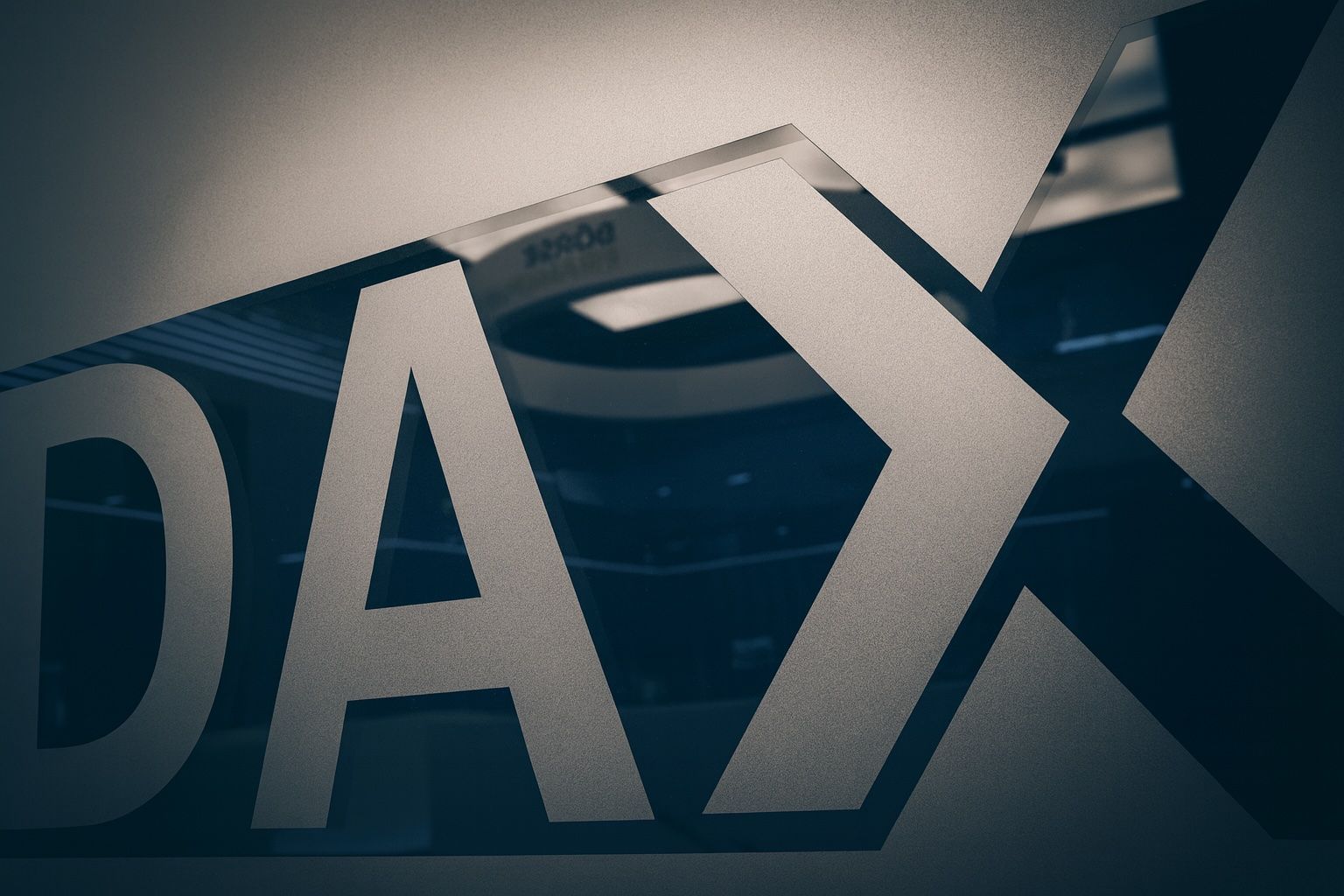- Germany’s DAX index tumbled around 1.5% in Tuesday trading, sliding back under the 24,000-point mark after a brief early-week rally [1]. Other major markets also lost ground, reflecting a broad risk-off mood across Europe and Asia.
- Investor nerves are frayed by dimming hopes for U.S. interest rate cuts, mounting fears of an “AI bubble” in tech stocks, and an ongoing U.S. government shutdown – a combination of factors that has put global markets on edge [2]. The DAX’s failure to hold 24,000 underlines how psychological hurdles are capping rebound attempts [3].
- Renewed trade tensions added to the gloom. A dispute over Chinese-owned chipmaker Nexperia – with Beijing curbing exports after the Netherlands tightened control – has unsettled the tech sector, reminding investors of geopolitical risks [4]. These headwinds abruptly ended the DAX’s “friendly” start to the week, turning optimism into caution.
- Corporate movers: Shares of dialysis provider Fresenius Medical Care (FMC) plunged nearly 6% and led DAX losers despite the firm’s strong quarterly results [5]. Traders cited speculation that parent company Fresenius might soon sell more of its FMC stake, pressuring the stock [6] [7]. JPMorgan analyst David Adlington noted FMC’s earnings beat but warned that further share placements by the parent could weigh on the share price [8].
- Outlook: Market analysts say the DAX’s months-long sideways trend may actually be setting the stage for a new uptrend. Falling prices have started to attract bargain hunters, according to a recent survey, suggesting that the current dip could increase buying interest and pave the way for a rebound [9]. However, in the near term, volatility may persist as investors await clearer signals on interest rates and tech valuations.
DAX Slides as Early-Week Rally Fizzles
After a solid start on Monday, Germany’s DAX index abruptly reversed course on Tuesday, dropping about 1.5% and falling below the 24,000-point threshold [10]. By midday, the DAX sank to around 23,750 points, giving up most of the prior session’s gains. This decline was in line with a broader market pullback: France’s CAC 40 was down roughly 1.3% and London’s FTSE 100 about 0.8% in the same session [11]. The sudden slump underscores how fragile recent gains have been – the DAX has been range-bound for months, and each attempt to rally has quickly met resistance [12]. “The sideways movement continues,” noted one analyst, who said only a slew of upbeat earnings reports might provide relief [13]. In other words, without fresh positive catalysts, the market’s momentum fizzled out almost as quickly as it started.
Analysts pointed out that the 24,000 level has become a psychologically important barrier for the German index [14]. The DAX briefly popped above that mark during the latest uptick, but Tuesday’s selling drove it right back down, confirming 24,000 as a formidable hurdle in the current environment [15]. The MDAX of mid-sized German stocks likewise fell over 1.4%, and the pan-European Euro Stoxx 50 index dropped by a similar magnitude [16]. This synchronized slide suggests a general retreat from risk assets, rather than any Germany-specific crisis. Market sentiment, which had been tentatively hopeful at the week’s start, has quickly swung toward caution as traders reassess the global risk factors at play.
Global Headwinds: Fed Signals, AI Bubble Fears & Trade Tensions
Behind the DAX downturn is a confluence of global headwinds that have soured investor appetite for stocks. First and foremost is the U.S. Federal Reserve’s stance. Hopes that the Fed might start cutting interest rates soon have faded, especially after recent signals from Fed officials. In fact, Fed policymakers like Chicago Fed President Austan Goolsbee have stressed they remain “nervous about the inflation side of the ledger,” hinting that rates may stay higher for longer [17]. As one trader observed, investors are now “scaling back expectations” of any further Fed rate cuts this year [18]. The prospect of prolonged high rates in the world’s largest economy has a chilling effect on equities globally, making future profits less valuable and raising borrowing costs for companies.
At the same time, markets are grappling with the possibility that the recent artificial intelligence (AI) stock boom may be overheated. Tech equities that soared on AI hype are now showing signs of overvaluation, prompting comparisons to the dot-com bubble of 2000 [19]. Some of the high-flying names suddenly stumbled: for example, U.S. software firm Palantir Technologies saw its stock plunge about 7% overnight after posting strong earnings, and chipmaker Nvidia also reversed course with a near 2% drop [20]. These abrupt moves rang alarm bells. “There’s growing concern that parts of the market, particularly AI-linked firms, have become detached from fundamentals,” one market trader warned [21]. The fear of an AI bubble bursting has introduced a new layer of uncertainty, leading investors to question whether the huge gains notched by tech stocks this year are truly justified. As a result, many are taking profits or shifting into safer assets, a trend that hit tech-heavy indices and spilled over into broader markets.
Political and geopolitical worries have only added to the risk-off mood. Notably, the United States is in the throes of a government shutdown as budget deadlock drags on, an unsettling backdrop that dents investor confidence [22]. The protracted shutdown not only threatens U.S. economic growth but also underscores deeper political dysfunction, which global investors watch warily. Meanwhile, fresh trade tensions between China and the West are resurfacing. In a prominent example, the Netherlands recently placed Chinese-owned chipmaker Nexperia under tighter government control (citing national security), and Beijing retaliated by halting certain chip exports from Nexperia’s Chinese plants [23]. Hopes had risen just days ago that this dispute might ease – there were tentative signs of détente to start the week – but those faded when China demanded that the Netherlands stop its “interference” and find a solution [24]. This renewed standoff over tech access has reminded investors of the fragile state of U.S.-China and EU-China relations, particularly in the strategic semiconductor sector. Supply chain risks and the specter of a broader trade war have quickly re-entered market calculations.
Taken together, the monetary policy uncertainty, AI bubble jitters, and policy conflicts (from Washington’s shutdown to Beijing’s export curbs) created a perfect storm of caution. “Schwindende Hoffnungen” – waning hopes – of easier money in the US, coupled with bubble fears and political strain, are clearly weighing on investors’ nerves [25]. It’s a sharp change in tone from just a week or two earlier, when signs of a U.S.–China trade truce and excitement over AI had pushed some indices to new highs. Now, however, safe-haven mindset is creeping back: bond yields have eased as some traders seek shelter, and stock buyers have become more selective, bracing for potential volatility ahead.
Stock Standouts: FMC’s Slide and Tech Tremors
Amid the broad decline, certain stocks and sectors stood out for their pronounced moves. One eye-catching loser on the DAX was Fresenius Medical Care (FMC), which saw its shares plunge by about 6% intraday [26]. By late morning, FMC was the DAX’s worst performer, sinking to roughly €43 per share – levels not seen since mid-September [27]. Ironically, this sell-off came despite FMC reporting better-than-expected quarterly results. The dialysis clinic operator delivered surprisingly strong revenue and earnings growth, benefiting from cost cuts and solid organic expansion across its businesses [28]. It even reaffirmed its full-year targets, normally a bullish sign. So why the steep drop? Market experts pointed to technical factors rather than fundamentals: Fresenius Medical Care’s parent company (healthcare group Fresenius SE) may be preparing to offload more of its stake in FMC, according to trader chatter [29] [30]. Fresenius SE had already sold a large block of FMC shares earlier in the year and agreed to a 180-day lock-up, which is now expiring [31]. This has fueled speculation that a new share placement – essentially, Fresenius dumping more FMC stock into the market – could be imminent. Such a move would increase the stock’s supply and potentially dilute value, so some investors rushed to sell first. “FMC delivered a surprisingly strong performance… however, expectations of a further share placement by major shareholder Fresenius could weigh on the stock,” JPMorgan analyst David Adlington warned, explaining the market’s reaction [32]. In short, technical selling pressure trumped good earnings news for FMC, illustrating how sensitive the current market is to supply-and-demand shifts (and how quickly sentiment can turn on a dime).
Beyond FMC, the technology segment faced headwinds as well, mirroring the international trend. Germany’s market doesn’t have the same mega-cap tech names as the U.S., but tech-linked firms and industrials still felt the pain of the global tech pullback. Chipmaker stocks and AI-exposed names were under pressure after the “beängstigende Rally” (alarming rally) in tech took a pause [33]. Investors in Frankfurt grew more cautious, especially toward high-valuation growth plays. Even Wall Street’s darlings gave off warning signs: U.S. futures showed Nasdaq tech stocks set to fall over 1% at the open Tuesday [34], following declines in Asia where markets like South Korea’s Kospi tumbled 2.4% after record highs [35]. All of this sent a clear message: the tech euphoria has cracked, at least for now. Companies that led the year’s gains – from AI software firms to electric vehicle makers – suddenly saw buyers step back. For instance, Amazon, which had surged on Monday after a $38 billion AI cloud deal, slipped over 1% as enthusiasm cooled [36]. And when a UK court ruled against Stability AI in a landmark copyright case, shares of Getty Images (plaintiff in that case) sank 8%, showing the legal risks around AI are being priced in [37]. These disparate developments all circle back to a common theme: tech and AI-centric stocks are no longer sure bets, and any hint of trouble can send them reeling. That, in turn, has cast a shadow over indexes like the DAX, where sectors like chemicals, autos, and industrial tech are influenced by the global cycle of tech investment. In summary, specific corporate stories – from FMC’s selloff to tech’s stumble – exemplified the market’s skittish mood, where good news can be overshadowed by larger anxieties.
Investor Sentiment and Forecast: Path to a Rebound?
With the DAX stuck in a stubborn trading range for months, many investors are asking: Where do we go from here? The current picture may look gloomy, but there are glimmers of optimism that this corrective phase could lay the groundwork for a healthier uptrend ahead. According to a recent Handelsblatt investor survey, the persistent sideways motion of the DAX – neither climbing nor collapsing – might actually be “preparing the next upward trend.” In fact, the survey found that falling stock prices have started to boost investors’ willingness to buy [38]. In simple terms, as the index has drifted lower and churned around 24,000, more bargain hunters are emerging on the sidelines, ready to pounce on quality stocks at a discount. This contrarian sentiment often comes into play when markets are subdued: pessimism creates value opportunities that savvy investors eventually recognize. If that dynamic holds, the DAX’s recent dips could be sowing the seeds for a future rally once the macro clouds begin to part.
Market strategists also note that some pressure could ease moving forward. For one, interest rate outlooks might become less threatening: while the Fed is currently in no rush to cut, most forecasters still expect rates to be lower by the end of 2025 than they are now. As inflation cools and recession risks rise, central banks may tilt dovish next year – a scenario that could buoy equities in the medium term. Additionally, valuation levels in Europe have come down during the stagnation. By some measures, European stocks (including German blue-chips) look relatively undervalued compared to U.S. peers [39]. If global investors regain confidence, there could be a rotation into these lagging markets. However, much depends on clearing the immediate hurdles. Clarity on U.S. fiscal policy (ending the shutdown) and stability in geopolitics (for example, avoiding escalation in trade wars or real wars) would go a long way toward restoring risk appetite. In the near term, traders are likely to remain “vorsichtig” (cautious) [40], as one German market report put it, watching data and central bank speak for any hint of a pivot.
In terms of forecast, don’t expect a straight line up – volatility is bound to persist. The coming days will bring more corporate earnings and possibly key speeches (several central bankers were slated to speak this week, keeping investors attentive [41]). Each new datapoint – whether it’s an inflation reading, a policy comment, or an AI news headline – could sway sentiment. Short-term sentiment is fickle, but the long-term narrative for stocks is not necessarily broken. Experts suggest that if the DAX can base out around current levels and avoid a deeper correction, it could mount a more sustainable year-end rally once uncertainties abate [42]. For now, though, markets are in “show me” mode – waiting for concrete evidence that interest rates will ease or that tech valuations make sense. Until that evidence arrives, the best strategy for investors may be patience and selectivity: staying alert for opportunities amid the turmoil, but also hedging against further shocks. In the words of one seasoned trader, “Confidence is in short supply at the moment, but that can change fast”. All it might take is one cooler inflation report or a breakthrough in Washington to flip the script. Until then, the DAX and its peers will likely inch forward with caution, hoping today’s jitters turn out to be tomorrow’s bargains.
Sources:
- dpa-AFX via Finanzen.net – “Aktien Frankfurt Eröffnung: Anleger werden wieder vorsichtiger” (Nov 4, 2025) [43] [44]
- ARD Tagesschau – “Marktbericht: Anleger enttäuscht über US-Geldpolitik” (Nov 4, 2025) [45]
- Times of India – “Tech stocks drag Wall Street lower as Fed rate cut hopes fade” (Nov 4, 2025) [46] [47]
- dpa-AFX/Handelsblatt – “Dax-Sentiment: Fallende Kurse erhöhen die Kaufbereitschaft” (Nov 3, 2025) [48]
- dpa-AFX via MarketScreener – “FMC Shares Drop Amid Speculation of Possible Placement by Fresenius” (Nov 4, 2025) [49] [50]
References
1. www.finanzen.net, 2. www.deineschlagerwelt.de, 3. www.deineschlagerwelt.de, 4. www.finanzen.net, 5. www.marketscreener.com, 6. www.marketscreener.com, 7. www.marketscreener.com, 8. www.marketscreener.com, 9. www.rss-verzeichnis.de, 10. www.finanzen.net, 11. timesofindia.indiatimes.com, 12. www.rss-verzeichnis.de, 13. www.handelsblatt.com, 14. www.deineschlagerwelt.de, 15. www.deineschlagerwelt.de, 16. www.finanzen.net, 17. timesofindia.indiatimes.com, 18. timesofindia.indiatimes.com, 19. timesofindia.indiatimes.com, 20. timesofindia.indiatimes.com, 21. timesofindia.indiatimes.com, 22. www.deineschlagerwelt.de, 23. www.finanzen.net, 24. www.finanzen.net, 25. www.deineschlagerwelt.de, 26. www.marketscreener.com, 27. www.marketscreener.com, 28. www.marketscreener.com, 29. www.marketscreener.com, 30. www.marketscreener.com, 31. www.marketscreener.com, 32. www.marketscreener.com, 33. www.finanzen.net, 34. timesofindia.indiatimes.com, 35. timesofindia.indiatimes.com, 36. timesofindia.indiatimes.com, 37. timesofindia.indiatimes.com, 38. www.rss-verzeichnis.de, 39. finance.yahoo.com, 40. www.finanzen.net, 41. www.rss-verzeichnis.de, 42. www.rss-verzeichnis.de, 43. www.finanzen.net, 44. www.finanzen.net, 45. www.deineschlagerwelt.de, 46. timesofindia.indiatimes.com, 47. timesofindia.indiatimes.com, 48. www.rss-verzeichnis.de, 49. www.marketscreener.com, 50. www.marketscreener.com







